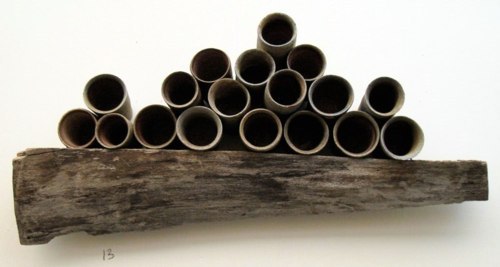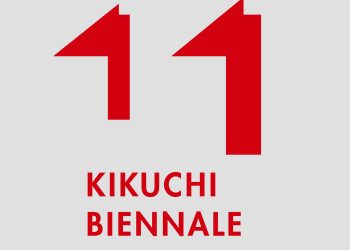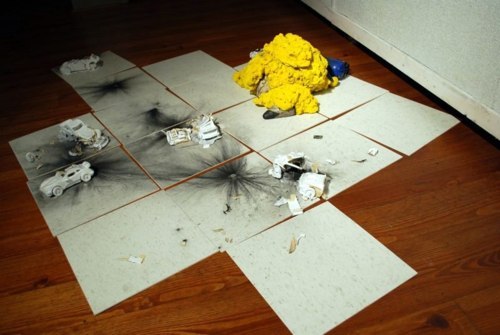
You’re a very prolific artist, with lots of exhibitions, lectures and workshops being held in the last years. How do you find the time needed for all of this? Do you also teach?
Thank you for the considering me prolific, that is an adjective that has been used before to describe not only the breadth and quantity of what I do and what I call “My” art but a diagnosis that I find most properly describes my unyielding need to make. I don’t know how to make art any other way…never have. I think that the only way to find the time to work “prolifically” is by making the best out of all the other tasks that you do. Be it exhibiting, lecturing, and teaching workshops. All of these moments and all of the moments not making provide us with a unique opportunity to think, plan and daydream. I need my time spent talking about other artists to think of how I am different. I also need my time as a Sunday afternoon mechanic fixing things around the house to remind my brain that my hands like moving this way or that. All of this activity then tells my wallet what kind of clay and glaze I need to use to keep my brain and hands satisfied. My brain still cannot keep up with my hands.
The teaching that I also do is like a buffet. In some ways, it provides me with necessary exercises that a growing artist needs to flourish. It also provides me with a multitude of materials and technologies to further understand the science and dexterity needed for ceramics. I find one of the most helpful aspects of teaching to be the communication development. When I started in education, I couldn’t walk a person through making a paper airplane, and now, through all of the practice I can teach all kinds of different styles of airplanes. Most importantly, I, myself, make a better airplane. This has been very helpful. Inevitably though, if you do too much, like any buffet…it isn’t healthy.
Like the system and language of chemistry, your works behave like an equation, trying to connect human relationships. Tell us about the process of constructing a new work, from sketch to firing.
This is a great question. One that I believe all artists answer differently at different times in their careers and lives. My works attempt to answer relationship equations in the final product but also in the process in which they are made. Like I say in just about every artist statement and writing I do, I see my art making and general studio process as a living, breathing, eating, growing and even more important, a mutating organism. One that is fed helpful amounts of media then distilled and filtered clumsily through screens made of new materials and techniques. Like any healthy science project, random samples are taken to ensure the highest quality of homogenization and communication. At times, it is similar to a chemical equation made of compounds and bonds, but one that is never ending, moving and ultimately unsolvable.
I am sure that we all do things like these in our pursuits to make art. For me, I believe it is important to keep the theme and scenarios of my project in mind. In the case of this work, the themes are systematic and a-systematic routines of study and classification. I think what you may be asking is whether or not I start with sketches and end in a fired ceramic work that installs in a viewing space. Of course I do. However, it rarely follows the paths that I see my colleagues using. Sometimes I wish it did because I wonder if I would be more productive with someone else’s art routine.
The journey that my work often follows begins with an accidental gluing of one thing to another and after a very calculated series of profanity and failures, what you see is my work…in all of it’s sticky, gooey, orb-ness.
What is your present project? Tell us about it.
Currently, I am transitioning my interests in the similarities between things like bullets and warfare and more benign things like ceramic vessels and planning, to my interests in bricks. We use them all over the world and we have been doing so for thousands of years. I am interested in the similarities of bricks used to make other bricks and…well…the other bricks. I am currently exploring the way we construct kilns and the structures we dwell in. As always, I am fascinated by some kind of system so I am intrigued by that which moves goods from one place to another. For example, I am just intrigued by wooden pallets and their use and prominence in trucking and warehousing. So naturally, I am making pallets that are about four to five inches long in hyper-detail upon which I am “palletizing” objects like ceramic cups (commercial and handmade alike) and Lego bricks.
It is pretty clear I cannot move away from the toys completely but I don’t think I have to. Somewhere in the heart of this anthropological and archeological study of bricks I think lies a psychological study requiring me to juxtapose the elementary presence of building blocks like Legos with their real, ceramic ancestors and brethren to explore the transition of A to B through mechanization and proliferation. I am wondering if this has anything at all to do with our progress as humans or is it just simple human behavior. I like toys. That much is obvious.
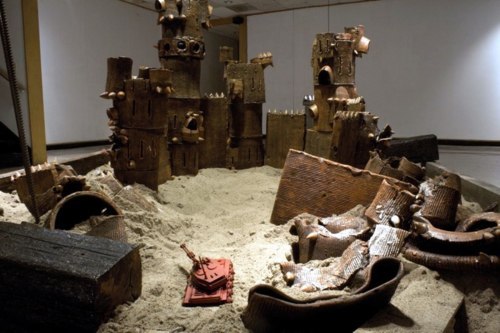
Parts sold separately (installation)
Where do you get your inspiration from and what motivates you?
This is a easy one to answer because the answer is so simple and fun. In a word, everywhere. I have always seen what I do as a sticky ball with a warm gooey center. It is most often ceramic so this description is certainly metaphorical. I rarely set out on a new project that is a whole lot different from that which came before. Because of this, I don’t think that I rely on a different set of stimuli. Just more of the same amounts of everything. Life seems to be supplying plenty of that on a daily basis.
To say that I do not rely heavily on the imagery in signage and labeling would be crazy but I don’t have to look far to see that. If it isn’t media of some kind flying into our eyes and ears at sub-sonic speeds it is signage. As a child of the late 80’s and 90’s I am hopelessly programed by the brightly colored and absurdly written cartoons of G.I. Joe & Ren and Stimpy. I and my contemporaries aren’t without realistic television though, we have Knight Rider and The A-Team to round out our experiences.
I grew up in a household of scientists. A chemist father and a biologist mother pre-programmed me with an interest in what is achievable through process and elimination. I see these influences as healthy and as something that just makes me who I am. When you combine that with a life spent in front of a TV and outside sending rockets into the air, I believe a few cross-disciplinary rocket/molecule/germ/teabowl forms will float to the surface.
Besides my subject matter, I the artist get the most motivation from my peers and former professors/mentors. They know who they are and it is all their fault.

Working with large-scale installations is not an easy job, but you manage somehow to inherit the space and make it work with you. Do you make many preparations when creating a new installation?
I make tons of them! Any installation, especially that which approaches the “site specific” type is a living, breathing thing and in my experience, it is also a cranky four year old. In the earliest stages I begin with about a thousand sketches that turn into a hundred drawings that then turn into a dozen schematics and lists. Oh how I love lists! There are so many factors at play when installing anything and when I install my particular flavor of strange, sticky and dimly lit messes, the limitations of the space and those of my materials become very important. There is no one way to do anything and I would never say that working the way I work would be good for anybody but I have to plan everything. From the smallest little surface on the floor of a gallery that I may or may not want to blow up black stain on with fireworks to the structure of the ceiling and whether it has a suspended ceiling that I am going to have to measure and thread wire through to hang a 75 lb. sphere from. Wow, if that isn’t a run-on-sentence than I don’t know what is…but I like it anyway!
In a nutshell yes…lots of preparations. In the end I end up doing more prep than art making or installing and that, for the time being, is getting the job done.
What are your future plans?
I bet everyone is saying some kind of global domination or something. At least I bet Ian F. Thomas is. I’m a modest person. You won’t see me walking around with a planet destroying laser cannon or anything. I might make a small ceramic replica of it but I would never make a real one with the potential of destroying another planet.
I enjoy teaching, in fact I feed off of it. I would like to be teaching a lot more and making less to be completely honest. Why, you might ask, would anyone want to make less? I feel that my work needs to be restricted behind a dam so to speak so that when I release it or it breaks free, it comes out with serious intensity. (This has to be the craziest answer to this question you will get.) Besides the implementation of project “Brick” within the arena that my work performs in, I would say that I also want the hand made vessel to come back to me in importance. I love making pots but until now I didn’t think I needed my hands to make any more. After all, I have plenty of bowls. The pots are reasserting themselves to me and telling me that 1, we have been here the entire time and 2, they are just as important and capable of a leading role in the drama that is my work. There was a time when the humble teabowl image in my work was a stand in for me the artist and me the person…that I like. Lately it has been Buzz Lightyear….I can do better than that.
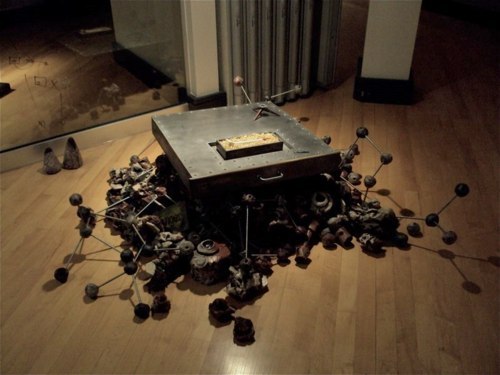
Rocket parts (installation)
“In my work, a tangible place exists where the fields of art making, weapons manufacturing and scientific research converge. This latest work is composed of these subjects existing in the same atmosphere, constantly crossing and colliding with one another as if part of the same charged electron cloud. This work as an endless equation of variables, values, formulas and solutions. Like the system and language of chemistry, these subjects are always around us and the characters, materials and scenarios of this equation and chain reaction are in constant motion.
In an effort to reflect on the early presence that these subjects have in our lives, this connectivity is expressed through a language specific to childhood and is punctuated with objects that reference my early education and play. The childish language in this work comments on two conclusions that stoke the fires of my work; the omnipresent nature of science in our daily lives and the similarity between objects used to discover and nurture and those used to destroy and capitalize.
I see this work as a mechanism to evaluate conflict as the direct result of two kinds of perennial human activities: misunderstanding – willful or otherwise – and the heroic yet flawed effort to understand through research and classification. The activities in my work show the nature of human relationships as seen through the lenses of our societies researchers and artists.” Ian Shelly
By Vasi Hirdo
Published in Ceramics Now Magazine Issue 1.
Visit Ian Shelly’s website.
View Ian Shelly’s profile on Ceramics Now.


